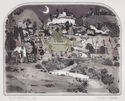
19th, 20th & 21st Century Fine Prints
707-546-7352 · fax 707-546-7924 · web: www.annexgalleries.com · email: artannex@aol.com
Graham Clarke Biography
Graham Clarke
British
1941
Biography
Graham Clarke, artist, author, illustrator and humorist, is one of Britain's most popular and best-selling printmakers. He has created some five hundred images of English rural life and history and of the Englishman's view of Europe. Born in 1941, Clarke's upbringing in the austerity of war-time and post-war Britain, made him reliant on his own imaginative resources. Responding to the comedy of everyday life, he brings his own unique brand of humour to his interpretation of past and present history through the eyes of the common man.
He was educated at Beckenham Art School, where he fell under the spell of Samuel Palmer's romantic and visionary view of the Shoreham countryside. At the Royal College of Art he specialised in illustration and printmaking, and pursued his interest in calligraphy. With encouragement from Edward Bawden, Clarke began refining an individual aesthetic, printing traditional landscapes marked by a sense of locality and genre. Graduating in 1964, he benefited from the print boom of the decade and, with commissions from Editions Alecto and London Transport Publicity Department a promising career was launched. The publication in 1969 of his first hand-printed "livre d'artiste", Balyn and Balan won recognition from the most influential patron and connoisseur of the day, Kenneth Clark. Lord Clark also wrote enthusiastically in praise of Vision of Wat Tyler: "the whole book is a splendid assertion that craftsmen still exist and cannot be killed by materialism. A few idealists are the only hope for decent values".
He has attracted universal admiration for his revival of beautiful, hand-coloured prints in the tradition of Thomas Rowlandson. The famous 'arched top' etchings, with which Graham Clarke established a widely successful reputation in Britain and overseas, came to public attention in 1973 when the first of these, Dance by the Light of the Moon, was exhibited in London at the Royal Academy of Arts Summer Show, and sold out
Examples of his work are held by Royal and public collections, including the Victoria and Albert Museum, the British Museum, the Tate Gallery and the National Library of Scotland in the United Kingdom, as well as by Trinity College, Dublin, the Library of Congress in Washington, D.C., the New York Public Library and the Hiroshima Peace Museum. Many more are to be found on the walls of private homes all over the world, collected systematically by devotees, as well as singly by ordinary art lovers who "know what they like". For over thirty five years Clarke has sustained a remarkable evolutionary development of his work, while remaining true to a philosophy of life and to a democratic ideal which he was already formulating as a schoolboy.
His books, Graham Clarke's "History of England", Graham Clarke's "Grand Tour" and "Joe Carpenter Son, An English Nativity", were published by Phaidon Press. The latter, a verse play, now having been performed more than 300 times in churches and schools worldwide. His 'discovery' of "W. Shakespeare Gent. His Actuale Nottebooke" saw the publication of a quite different work in 1992. This has been followed by "Engelskmann I Lofoten" a Norwegian Sketchbook in 1996. Spring 2000 saw the publication of 'Bait Box Stew', sketches and notes from his beloved Cornwall, and 'KENT', a collection of watercolours on his home territory.
At a ceremony in Canterbury Cathedral in July 1993, an Honorary Degree of Master of Arts was conferred upon Graham Clarke by the University of Kent and in August 1993 Graham was made a Chevalier de la Confrerie du Ceps Ardechois in his favourite part of Southern France. Graham was also named as the Fine Art Trade Guild Artist of the Year 1993. In 1999 he was asked to become an official ambassador for the County of Kent, a role which he pursues with much enthusiasm. For the last twelve years his work has taken him regularly to Japan where he has now become that country's most popular British artist. Kodansha, Japan's largest book publisher, issued "The World of Graham Clarke", an introduction and explanation of eighty Clarke etchings in Japanese, a second edition has now been printed.
Graham Clarke's Millennium window is to be seen in his own parish church of Boughton Monchelsea, Kent. It is unique in that it involves light and sound as well as the stained glass itself. During the year 2000 he produced a large composite wood carving 'The Gloucester Nativity'. Gloucester Cathedral is its home but it is designed to travel and forms the centrepiece at Clarke's retrospective exhibition held at The Royal Museum and Art Gallery, Canterbury in 2001.
Graham Clarke is a man with an overriding sense of tradition, and of religious, social and historical continuities. He takes pride in his view of himself as a local man, a "Man of Kent", with a firm faith in the peace and stability of family, home and community. As such, life and art have always been interdependent, mutually sustaining activities. His wife Wendy, his four children, his animals and friends, the cottage industry he maintains in the village of Boughton Monchelsea where he lives, his comedy band, and the surrounding landscape, offer a microcosm of the world and its history. The scenes he depicts represent both for him and for his everwidening audience, an idyll and a universal ideal.
https://www.grahamclarke.co.uk/Graham-Clarke-Biography.html

